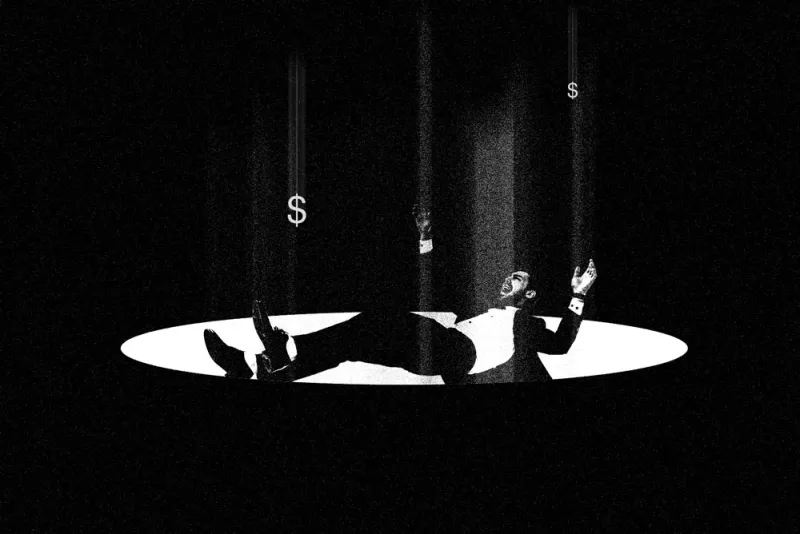
Illustration by II
As I watched a 2,000-point sell-off in the Dow Jones Industrial Average on Thursday, March 12, I realized that Tim Lee — the founder and chief economist at piEconomics — had got it all figured out before he recently retired.
Along with co-authors Jamie Lee (no relation) and Kevin Coldiron in The Rise of Carry, he laid out his theory of how unprecedented levels — and types of — central bank intervention in financial markets over the past few decades have turned the global economy into a series of overlapping carry trades.
First, let’s start with the simplest example of a currency carry trade: It’s one where an investor borrows assets in a low-yielding currency and then invests the funds into a higher-yielding, typically riskier currency. For example, today one can borrow Swiss francs at –0.75 percent and invest in short U.S. rates at 1.25 percent, earning a nice 2 percent nominal spread, which is amplified by the use of substantial leverage — sometimes 10-, 20-, even 60-to-1.
The danger, of course, is that the currency that the trader is long depreciates against the funding currency, and that’s certainly what uncovered interest rate parity posits must happen: You shouldn’t be able to simply access an arbitrage in the rates market. Instead, the currency you are long should in theory depreciate against the currency you are short by the exact interest rate differential. In the example above, the dollar should fall 2 percent against the Swiss franc, making the trade a wash.
However, as often happens with financial theory, the opposite holds in reality.
Usually, the higher-yielding currency continues to appreciate in value as other investors pile into the trade in search of returns, and the higher-yielding economy is subsequently flooded with capital inflows.
Unfortunately, though, the game must come to an end. It always does.
Whether the catalyst is runaway inflation or central bank missteps — or perhaps a broader dislocation that sends investors fleeing to the safety of the funding currency — at some point all that levered hot money flows out even faster than it came in, creating a sawtooth-like return pattern.
When I covered currency funds at Mercer — such as the now defunct FX Concepts and QFS Asset Management — we called this return pattern “up an escalator, down the elevator” because although the gains compound slowly, the losses occur sharply as broker margin calls push sellers to exit even faster. This selling also increases the downward pressure on prices, exacerbating selling in a vicious cycle.
This is undoubtedly how equity markets have felt the past several weeks.
In The Rise of Carry, Lee demonstrates how this type of trade is no longer limited to currency markets, as central bank actions have pushed investors out on the risk curve to get the returns they need — and in so doing have increased the perceived “moneyness” of other assets.
Consider that the yield on an average certificate of deposit, an instrument often used to park cash needed six months later, was 4.25 percent in 1999. Of course, back then the federal funds rate hovered at about 5 percent.
With fed funds at 1.25 percent today (and 30-year Treasuries yielding about the same), low interest rates combined with yield curve compression have forced investors out the credit risk spectrum. One can easily pick up some high-yield mortgage-backed securities for roughly 6 percent today, and most large fixed-income investors have more credit in their portfolios than Treasuries. If you need to have “safe” investments for six months to a year with a little yield, true risk-free assets won’t get you there.
Some might note that such asset-backed securities are clearly not guaranteed by the full faith and credit of the U.S. government. Though this is true, since the 2008 credit crisis the Federal Reserve has been the buyer of last resort, scooping up more than $4 trillion worth of such securities. It’s hard to argue that such unconventional easing strategies don’t signal to the market that the Fed stands ready to provide a similar guarantee to that which the Treasury provides for the dollar. In fact, it would almost be irrational to claim this backstop should not be priced into underwriting risk versus return in yielding assets.
Well, these same interventions compress returns in these target sectors, then push market participants further out on the risk spectrum. Lee argues they have even incentivized what is essentially corporate carry behavior — namely, the issuance of debt to buy back stock, which has become the easiest and most reliable method of producing earnings growth.
In 2019 the aggregate value of corporate bond issuance, according to the Securities Industry and Financial Markets Association, was about $1.4 trillion; the majority of these proceeds went to fund share repurchase programs, which for companies in the S&P 500 exceeded $1 trillion for the first time ever. Even with such aggressive buybacks — shrinking the number of shares in the denominator of an earnings-per-share calculation — EPS growth last year was still only roughly flat. Growth is stagnating as interest service payments and carry trades are crowding out real investment.
But there is another type of equity carry at play — namely, the use of explicit leverage to fund stock purchases. Broker margin debt has hovered near all-time highs the past few years as well, with nearly $600 billion of additional stock ownership financed via leverage. This margin utilization is more than double what it was before the 2008 crisis. Despite hefty effective annual rates of about 9 percent, this margin debt can still fund an attractive carry trade when equities have a 30 percent year, as they just did.
And the sell-off becomes a self-fulfilling prophecy, as dropping equity levels trigger margin calls, leading to even more forced selling. The result is an explosion in market volatility, and volatility of volatility. Of course, this is only exacerbated by the lack of true specialists making two-way markets; they have been replaced by high-frequency traders and algorithms that flip signs to quickly short into market weakness.
In fact, the action looks a lot more like a typical carry collapse than a rational market correction. Even the 2008 market decline was nowhere near as explosive as the movement we’ve seen in the past week.
With the Dow down nearly 10 percent, one might suspect Treasuries and gold would be up. That was not the case. Gold fell 4 percent, and long-dated Treasuries were off by nearly 1.5 percent. The indiscriminate nature of the selling is a sign that traders need liquidity wherever they can find it to meet broker calls.
For institutions with large equity exposures, this sell-off is certainly painful — but overreacting to market corrections will only compound the pain. At the same time, I’m not sure that jumping back in with both feet is a great idea, either: Bear markets tend to overcorrect, and the extent of a downside overreaction is often proportional to the earlier overvaluation. In this case, there will be some severe financial effects from all the economic shutdowns because of the coronavirus. Given the size of the industries affected, I’d wager we are already in a technical recession. One or two quarters from now, if negative GDP and S&P earnings numbers come out, that equity multiple can surely rerate lower, and on lower earnings.
In the meantime, in private markets we aren’t as worried about valuations as about cash flows. Covenant light means technical defaults won’t be as big a problem this time around as they were in the last crisis, but payment defaults will be. Indeed, we are hearing that some lower middle-market businesses — like those local firms here in Austin, Texas, that were expecting four to six months’ worth of annual revenue over the next two weeks from the now canceled $350 million South by Southwest festival — are already stressed, leaving private lending firms scrambling.
As much as I’d love to jump in and start scooping up bargains, I think this elevator has a few more stops before it bottoms.





